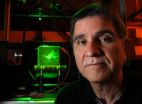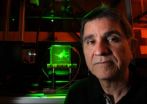(Press-News.org) Researchers at the Ernest Gallo Clinic and Research Center at the University of California, San Francisco, and Pfizer Inc., have determined that two new compounds may be effective in treating both alcohol and nicotine dependence at the same time.
In a paper published in the November 3, 2010 issue of Neuropsychopharmacology, the researchers showed that alcohol consumption in rodents was significantly decreased by two compounds that target neuronal nicotinic acetylcholine receptor (nAChR) subtype 34*.
nAChRs are proteins found in the brain and broader central nervous system that mediate the effects of substances such as nicotine. Recent human genetic studies have shown that the genes encoding the 34* subtype are of significant importance for susceptibility to both alcohol and nicotine dependence.
"The problem has been translating these important genetic findings into more effective medications for people," said co-senior author Selena E. Bartlett, PhD, director of the Preclinical Development group at the Gallo Center. The lead author of the study is Susmita Chatterjee, PhD, of the Gallo Center.
The work was done in collaboration with scientists led by co-senior author Hans Rollema, PhD, in the Neuroscience Research Unit at Pfizer Inc.
One of the new compounds, CP-601932, has been shown in a clinical study to be safe in humans, notes Bartlett. She recommends a clinical study to evaluate the compound's efficacy and potential benefits in treating both alcohol and nicotine dependence.
The other compound is PF-4575180. Both were developed by Pfizer.
"Alcohol and nicotine addiction are often treated as separate disorders," Bartlett says, "despite the fact that 60 to 80 percent of heavy drinkers smoke tobacco. There are very few effective strategies for treating these disorders separately, let alone together. Our data suggest that by targeting specific nAChR subtypes, it may be possible to treat both alcohol and nicotine dependence with one medication."
Significantly, while the compounds had a significant effect on the rodents' alcohol consumption, their intake of sucrose was not affected. "This indicates that unlike currently approved alcohol abuse medications, the compounds do not interfere with the brain's natural reward system in a larger way," says Bartlett.
INFORMATION:
Co-authors of the study are Pia Steensland, PhD, of the Karolinska Institutet, Sweden, Jeffrey A. Simms, BSc, and Joan Holgate, BSc, of the Gallo Center, and Jotham W. Coe, PhD, Raymond S. Hurst, PhD, Christopher L. Shaffer, PhD, and John Lowe, PhD, of Pfizer.
The study was supported by funds from the National Institutes of Health, the US Department of Defense, the State of California, the Foundation BLANCEFLOR Boncompagni-Ludovisi, née Bildt, the Sweden-America Foundation, and Insamlingsstiftelsen Hjärnfonden/The Swedish Brain Foundation.
The UCSF-affiliated Ernest Gallo Clinic and Research Center is one of the world's preeminent academic centers for the study of the biological basis of alcohol and substance use disorders. Gallo Center discoveries of potential molecular targets for the development of therapeutic medications are extended through preclinical and proof-of-concept clinical studies.
UCSF is a leading university dedicated to promoting health worldwide through advanced biomedical research, graduate-level education in the life sciences and health professions, and excellence in patient care.
Follow UCSF on Twitter http://twitter.com/ucsf
New compounds may treat both alcohol and cigarette addictions
2010-11-04
ELSE PRESS RELEASES FROM THIS DATE:
Moving holograms: From science fiction to reality
2010-11-04
Remember the Star Wars scene in which R2D2 projects a three-dimensional image of a troubled Princess Leia delivering a call for help to Luke Skywalker and his allies? What used to be science fiction is now close to becoming reality thanks to a breakthrough in 3D holographic imaging technology developed at the University of Arizona College of Optical Sciences.
A team led by optical sciences professor Nasser Peyghambarian developed a new type of holographic telepresence that allows the projection of a three-dimensional, moving image without the need for special eyewear ...
Gladstone scientists identify process by which Alzheimer's disease creeps through the brain
2010-11-04
SAN FRANCISCO, CA – November 3, 2010—Scientists at the Gladstone Institute of Neurological Disease (GIND) have offered new information about the events that underlie the "spread" of Alzheimer's disease (AD) throughout the brain. The research, published in the November 4th issue of the journal Neuron, follows disease progression from a vulnerable brain region that is affected early in the disease to interconnected brain regions that are affected in later stages. The findings may contribute to design of therapeutic interventions, as targeting the brain region where AD originates ...
UCLA autism study reveals how genetic changes rewire the brain
2010-11-04
Many gene variants have been linked to autism, but how do these subtle changes alter the brain, and ultimately, behavior?
Using a blend of brain imaging and genetic detective work, scientists at UCLA's David Geffen School of Medicine and Semel Institute for Neuroscience and Human Behavior are the first to illustrate how genetic variants rewire the brain. Published in the Nov. 3 online edition of Science Translational Medicine, their discovery offers the crucial missing physical evidence that links altered genes to modified brain function and learning.
"This is a key ...
MIT chemists engineer plants to produce new drugs
2010-11-04
CAMBRIDGE, Mass. -- Humans have long taken advantage of the huge variety of medicinal compounds produced by plants. Now MIT chemists have found a new way to expand plants' pharmaceutical repertoire by genetically engineering them to produce unnatural variants of their usual products.
The researchers, led by Associate Professor Sarah O'Connor, have added bacterial genes to the periwinkle plant, enabling it to attach halogens such as chlorine or bromine to a class of compounds called alkaloids that the plant normally produces. Many alkaloids have pharmaceutical properties, ...
Damage to prefrontal cortex compensated by intact areas, showing flexible nature of memory
2010-11-04
Brain research over the past 30 years has shown that if a part of the brain controlling movement or sensation or language is lost because of a stroke or injury, other parts of the brain can take over the lost function – often as well as the region that was lost.
New research at the University of California, Berkeley, shows that this holds true for memory and attention as well, though – at least for memory – the intact brain helps out only when needed and conducts business as usual when it's not.
These results support the hypothesis that memory is not stored in one place, ...
The emergence of holographic video
2010-11-04
Researchers at the University of Arizona (UA), Tucson, have developed a holographic system that can transmit a series of 3D images in near-real-time, a precursor to holographic videoconferencing.
The system incorporates a novel, photorefractive polymer--one that can rapidly refresh holographic images and is scalable for production--coupled to a unique system for recording and transmitting 3D images of individuals and objects via Ethernet.
Lead author Pierre-Alexandre Blanche and his colleagues from the university and Nitto Denko Technical Corp. of Oceanside, Calif., ...
Study reveals why brain has limited capacity for repair after stroke, IDs new drug target
2010-11-04
Stroke is the leading cause of adult disability, due to the brain's limited capacity for recovery. Physical rehabilitation is the only current treatment following a stroke, and there are no medications available to help promote neurological recovery.
Now, a new UCLA study published in the Nov. 11 issue of the journal Nature offers insights into a major limitation in the brain's ability to recover function after a stroke and identifies a promising medical therapy to help overcome this limitation.
Researchers interested in how the brain repairs itself already know ...
UBC researchers shine light on congenital heart disease 'hot spots' using Canadian Light Source
2010-11-04
Using the Canadian Light Source synchrotron and the Stanford Synchrotron Radiation Lightsource, a team of researchers from the University of British Columbia has shed light on the ryanodine receptor, a structure within muscle cells that has been linked to life-threatening congenital heart conditions.
The findings were published online today in the journal Nature.
"The ryanodine receptor is a complex molecular machine within muscle cells," says Filip Van Petegem, an assistant professor in UBC's Department of Biochemistry and Molecular Biology and lead author of the study. ...
Asthma drug prevents spread of breast cancer: study
2010-11-04
TORONTO, Ont. — November 1, 2010 — A drug commonly used in Japan and Korea to treat asthma has been found to stop the spread of breast cancer cells traditionally resistant to chemotherapy, according to a new study led by St. Michael's pathologist Dr. Gerald Prud'homme.
"Tranilast, a drug approved for use in Japan and South Korea, and not in use in Canada or the U.S., has been used for more than two decades to treat asthma and other allergic disorders including allergic rhinitis and atopic dermatitis," Dr. Prud'homme says. "Now, our study is the first to discover it not ...
Simple blood test may diagnose deadly Niemann-Pick type C disease
2010-11-04
VIDEO:
Niemann-Pick type C, a fatal genetic disorder that frequently takes years to diagnose, may now be detectable with a simple blood test, according to researchers at Washington University School of...
Click here for more information.
A fatal genetic disorder that frequently takes years to diagnose may soon be detectable with a simple blood test, researchers at Washington University School of Medicine in St. Louis and the National Institutes of Health (NIH) report this week ...


